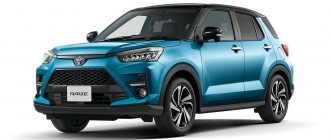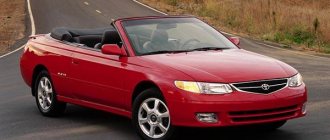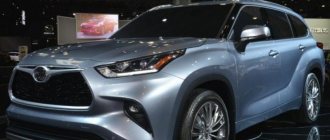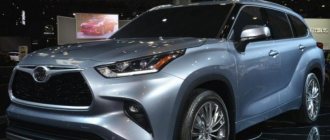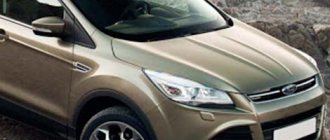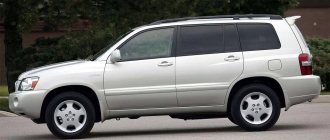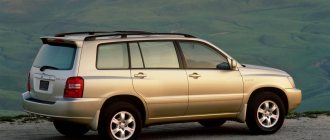I picked up my 2014 Toyota Highlander just two weeks ago. Straight to the point. I chose the Prestige package with all-wheel drive and a 3.5-liter gasoline engine with 249 horsepower. I want to share my impressions of driving a Toyota Highlander, although only two weeks have passed. I hope that the information will be useful for someone. Before that I had an X5. An excellent car, but with a “jamb” that I couldn’t fix, I wasted a lot of money. Of course, I no longer wanted to switch to a lower-level crossover. Therefore, after looking at many test drives and reading a huge number of reviews, I decided to buy a Toyota Highlander 2014. What criteria did I use to choose a car:
- Off-road body.
- Ground clearance must be at least 200 millimeters.
- Reliability.
- Comfort.
Toyota Highlander 2014 3.5l
I didn’t find an alternative to the Toyota Highlander, the only question was the Skoda Yeti, but after comparing the characteristics everything fell into place. I didn’t buy diesel for a reason known to everyone: what if bad fuel gets in? When I bought the Toyota Highlander, I was worried about its length. I thought that our cramped city would be too crowded for him. Upon arrival at the salon, a surprise awaited me, because of which I almost abandoned the crossover. The “metallic gray” color turned out to be completely different, it was different from the color in the catalog on the official website.
Comfortable salon
Surprises during purchase
It was an unpleasant surprise for me, because I expected to see a completely different car. But after taking a closer look at the car and spinning around, I realized that this color also looks great. The color itself was pleasant, it was just the fact of surprise that played into it. After spending about an hour on registration (the car dealership in Samara works quickly), we rushed home to Volgograd. When making stops, I ran out of the car and looked at my new crossover, thinking about what the 2014 Toyota Highlander reminded me of. In its appearance, I saw touches from the Hummer and from the limousine. If you look at it from the rear, it seems small and resembles a RAV4, there is something from the Q7 on the side, and the face of a leopard in the front. I liked the small windows and the huge interior, which doesn’t seem like it from the outside. Another surprise was the discovery the next day that they forgot to install parking sensors on my new Toyota Highlander. There was nothing to do, I had to wait for the package to be delivered to my home. Then I had to install it myself.
Pros and cons of the car
Well, now let's move on to the car. Upon returning home, I decided to take a trip to familiar places. And, unfortunately, I was disappointed - the Toyota Highlander 2014 was noticeably wobbling from the smallest bumps. With a sad mood and a desire to sell this “junk” to the first person I met, I returned home. There I decided to pour out my suffering on the forum, maybe there was some kind of solution. And it was true - competent people advised me to lower the pressure in the tires, which I did. From the standard 2.4 I lowered the pressure to 2.1 and everything fell into place. Toyota Highlander began to sail like a ship over all the bumps and irregularities.
Toyota Touch 2
Now the main advantages of the car. This is, first of all, a powerful engine. As other reviews say, it is enough for all types of coverage. The ride is also a huge plus of the Highlander - the crossover is easy to drive, the weight of more than two tons is not even felt when driving. There were no complaints about the brakes or braking systems either. As I understand from reviews and feedback, the previous Highlander had rather weak brakes. In the city, I also didn’t feel any inconvenience due to its size. Everything is compensated by the excellent handling that the new car received. After reading the reviews, I noticed that many drivers complain about the sound insulation of the Toyta Highlander 2014. In my opinion, everything is excellent. That's all.
If you have something to share or tell, something new about your car, leave your comments below and we will definitely publish them.
Features of Toyota all-wheel drive (1)
Eugenio,77 [email protected] © newniva.ru Feb 2004 — Feb 2021
Part 1. Original front-wheel drive models with automatic transmission/CVT Part 2. Original rear-wheel drive models with automatic transmission Part 3. Original front-wheel drive models with manual transmission
Let's start a brief overview of the main schemes for implementing all-wheel drive on Toyota cars with the most widespread version - with a transverse engine and automatic transmission.
| 1.1. Permanent all-wheel drive |
Permanent all-wheel drive. The center differential is symmetrical bevel (torque distribution between the front and rear wheels is 50/50), locked by a multi-plate hydromechanical clutch.
The A241H is a gearbox with simple hydraulic control and the locking control in it is quite primitive (detailed description - “Automatic Transmission A241H”), while the more advanced A540H implements full electronic control with feedback (detailed description - “Automatic Transmission A540H”).
The maximum blocking coefficient is realized by the control system in the “L” and “R” ranges.
The “C.DIFF AUTO” mode, activated using the button, allows the control unit to automatically select the blocking coefficient depending on driving conditions; when it is turned off, the center differential remains in a free state. The button is present on all models with the A241H and on early models with the A540H (on models after 1994, the button is absent and the automatic mode is always activated).
The automatic mode is the nominal mode for everyday driving; it can be turned off only when towing the car or using a spare wheel (excerpt from the instructions).
| Model | Release | Transmission | Differential locks |
| Caldina 190 | 1992-2002 | 4AT A540H AF2BE | interaxle - hydromechanical clutch with electronic control |
| Carina 190 | 1992-1996 | 4AT A540H AF2BE | interaxle - hydromechanical clutch with electronic control |
| Carina 210 | 1996-08.1998 | 4AT A540H AF2BE | interaxle - hydromechanical clutch with electronic control |
| Carina ED 200 | 1993-1998 | 4AT A540H AF2BE | interaxle - hydromechanical clutch with electronic control |
| Corolla / Sprinter 90 | 1987-1992 | 4AT A241H | interaxial - hydromechanical coupling |
| Corolla / Sprinter 100 | 1992-2002 | 4AT A241H | interaxial - hydromechanical coupling |
| Corolla / Sprinter 110 | 1995-2000 | 4AT A241H | interaxial - hydromechanical coupling |
| Corolla Spacio 110 | 1997-2002 | 4AT A241H | interaxial - hydromechanical coupling |
| Corona 190 | 1992-1996 | 4AT A540H AF2BE | interaxle - hydromechanical clutch with electronic control |
| Corona 210 | 1996-12.1997 | 4AT A540H AF2BE | interaxle - hydromechanical clutch with electronic control |
| Corona Exiv 200 | 1993-1998 | 4AT A540H AF2BE | interaxle - hydromechanical clutch with electronic control |
| Ipsum 10 | 1996-04.1998 | 4AT A540H AF2BE | interaxle - hydromechanical clutch with electronic control |
| RAV4 10 | 1994-2000 | 4AT A540H AF2BE | interaxle - hydromechanical clutch with electronic control, rear - Torsen (optional) |
| Sprinter Carib 95 | 1988-1995 | 4AT A241H | interaxial - hydromechanical coupling |
| Sprinter Carib 110 | 1995-2002 | 4AT A241H | interaxial - hydromechanical coupling |
| Vista/Camry 20 | 1988-1990 | 4AT A540H AF2BE | interaxle - hydromechanical clutch with electronic control |
| Vista/Camry 30 | 1990-1994 | 4AT A540H AF2BE | interaxle - hydromechanical clutch with electronic control |
| Vista/Camry 40 | 1994-1998 | 4AT A540H AF2BE | interaxle - hydromechanical clutch with electronic control |
Also interesting: How to use the transfer case on a Suzuki Grand Vitara?
Permanent all-wheel drive. The center differential is symmetrical bevel (torque distribution between the front and rear wheels is 50/50), locked by a viscous clutch.
In this scheme, an optional rear limited-slip differential of the Torsen type was often used.
| Model | Release | Transmission | Differential locks |
| Alphard 10 | 2002-2008 | 4AT U140F MF2AV | center - viscous coupling, rear - Torsen (optional) |
| Caldina 215W GTT | 1997-2002 | 4AT U140F MF2AV | interaxle - viscous coupling |
| Caldina 246 GT4 | 2002-2007 | 4AT U140F MF2AV | center - viscous coupling, rear - Torsen (optional) |
| Harrier 10 | 1997-2003 | 4AT U140F MF2AV | center - viscous coupling, rear - Torsen (optional) |
| Harrier ACU35/GSU3# | 2003-2021 | 4AT U140F MF2AV 5AT U151F MF2AV | center - viscous coupling, rear - Torsen (optional) |
| Highlander 20 | 2000-2003 | 4AT U140F MF2AV | center - viscous coupling, rear - Torsen (optional) |
| Kluger | 2000-2007 | 4AT U140F MF2AV | center - viscous coupling, rear - Torsen (optional) |
| Lexus RX MCU3# | 1998-2003 | 4AT U140F MF2AV | center - viscous coupling, rear - Torsen (optional) |
| Lexus RX350 GSU3# | 2006-2008 | 5AT U151F MF2AV | interaxle - viscous coupling |
| RAV4 20 | 2000-2006 | 4AT U140F MF2AV | center - viscous coupling, rear - Torsen (optional) |
Permanent all-wheel drive. The center differential is symmetrical bevel (torque distribution between the front and rear wheels 50/50), free.
The emulation of locks is carried out using the stabilization system (VSC) - the slipping wheel is forcibly braked, thereby increasing the torque on the other wheel of the same axis. Likewise, the torque is redistributed between the front and rear axles.
| Model | Release | Transmission |
| Harrier MCU35 | 2003-2006 | 4AT U140F' |
| Highlander 20 | 2003-2007 | 4AT U140F' |
| Highlander 40 | 2007-2021 | 5AT U151F |
| Sienna 20 | 2003-2021 | 5AT U151F |
| Lexus RX MCU35 | 2003-2006 | 4AT U140F' MF2A |
| 1.2. Plug-in all-wheel drive |
Permanent front-wheel drive, without center differential, connecting the rear wheels with a viscous-friction clutch.
The RBC clutch connects the two parts of the intermediate driveshaft and is activated when the front wheels slip; the rest of the time the car remains front-wheel drive.
Details - “Toyota all-wheel drive. V-Flex."
| Model | Release | Transmission |
| bB 30 | 2000-2005 | 4AT U340F |
| Funcargo | 1999-2005 | 4AT U340F |
| East 60 | 2002-2007 | 4AT U340F |
| Platz | 1999-2005 | 4AT U340F |
| Porte 10 | 2004-2021 | 4AT U340F |
| Raum 10 | 1997-2003 | 4AT A244F CF1A |
| Raum 20 | 2003-2021 | 4AT U340F |
| Starlet 80 | 1989-1996 | 4AT A244F CF1A |
| Starlet 90 | 1996-1999 | 4AT A244F CF1A |
| Tercel / Corsa / Corolla II 40 | 1990-1994 | 4AT A244F CF1A |
| Tercel / Corsa / Corolla II 50 | 1994-1999 | 4AT A244F CF1A |
| Vitz 10 | 1999-2005 | 4AT U340F MF1A |
| Will Cypha | 2002-2005 | 4AT U340F |
Permanent front-wheel drive, without center differential, connecting the rear wheels with a viscous-friction clutch.
The viscous coupling connects the two parts of the intermediate driveshaft and is activated when the front wheels slip; the rest of the time the car remains front-wheel drive.
| Model | Release | Transmission |
| Probox/Succeed 50 | 2002-2021 | 4AT U340F |
| Probox/Succeed 160 | 2021-.. | CVT K310F |
Permanent front-wheel drive, without center differential, connecting the rear wheels with a viscous coupling.
A viscous coupling filled with silicone liquid connects the driveshaft to the input shaft of the rear gearbox and is activated when there is significant slipping of the front wheels; the rest of the time the car remains front-wheel drive.
Details - “Toyota all-wheel drive. V-Flex."
| Model | Release | Transmission |
| Avensis 250 | 2003-2008 | 4AT A248F |
| bB 20* | 2006-2021 | — |
| Belta | 2005-2021 | 4AT U441F |
| Caldina 215G | 1997-2002 | 4AT A241F,A243F MF1A |
| Caldina 240 | 2002-2007 | 4AT A248F MF1A |
| Camry / Camry Gracia / Mark II Qualis V20 | 1997-2001 | 4AT A541F |
| Camry V30 | 2001-2006 | 4AT U140F" |
| Camry V40 | 2006-2021 | 4AT U140F" |
| Carina 210 | 08.1998-2001 | 4AT A241F,A243F MF1A |
| Corolla/Fielder/Runx/Allex 120 | 2000-2006 | 4AT U340F,U341F MF1A |
| Corolla Axio / Fielder 140 | 2006-2021 | CVT K310F, K311F |
| Corolla Spacio 120 | 2001-2007 | 4AT U341F |
| Corona 210 | 12.1997-2001 | 4AT A241F,A243F MF1A |
| Duet* | 1998-2004 | — |
| Matrix 130 | 2002-2006 | 4AT U341F |
| Opa | 2000-2005 | 4AT U341F MF1A |
| Passo 10* | 2004-2021 | — |
| Passo 20* | 2021-2021 | — |
| Passo 700* | 2021-.. | — |
| Pixis Epoch LA310* | 2021-2021 | — |
| Pixis Epoch LA360* | 2021-.. | — |
| Pixis Joy* | 2021-.. | — |
| Pixis Mega* | 2021-.. | — |
| Pixis Space* | 2021-.. | — |
| Premio / Allion 240 | 2001-2007 | 4AT U341F MF1A |
| Premio / Allion 260 | 2007-2021 | CVT K311F |
| Ractis 100 | 2005-2021 | 4AT U340F |
| Sienta 80 | 2003-2021 | 4AT U340F |
| Tank/Roomy* | 2021-.. | — |
| Vista 50 | 1998-2003 | 4AT U240F MF1A |
| Vitz 90 | 2005-2021 | 4AT U441F |
| Voltz | 2002-2004 | 4AT U341F |
| Will VS | 2001-2004 | 4AT U341F |
* — Daihatsu models sold under the Toyota brand. Permanent front-wheel drive, without center differential, rear wheels connected by an electromechanical clutch.
The coupling connects the driveshaft to the input shaft of the rear gearbox. In most cases, the car remains front-wheel drive, but if necessary, the control system automatically maintains the programmed value of the torque transmitted to the rear wheels.
Details - “Toyota all-wheel drive. ATC."
The initial name is “Active Torque Control”; after 2021, on some models the system receives the designation “Dynamic Torque Control”.
| Model | Release | Transmission |
| Alphard/Vellfire 20 | 2008-2021 | 6AT U660F |
| Alphard/Vellfire 30 | 2021-.. | CVT K115F |
| Auris 150 | 2007-2021 | CVT K310F,K311F |
| Auris 180 | 2021-2021 | CVT K310F |
| Blade 150 | 2007-2021 | CVT K112F |
| C-HR | 2021-.. | CVT K313F |
| Camry V70 | 2020-.. | — |
| Corolla Axio 160 | 2021-.. | CVT K310F |
| Corolla Fielder 160 | 2021-.. | CVT K310F |
| Corolla Rumion 150 | 2007-2021 | CVT K311F |
| Corolla Sport 210 | 2021-.. | CVT K310F |
| Estima 40 | 1999-2006 | 4AT U140F"' |
| Estima 50 | 2006-2021 | 6AT U660F"' |
| Gaia | 1998-2004 | 4AT A243F MF1A |
| Harrier 60 | 2021-2020 | CVT K114F |
| Harrier 80 | 2020-.. | CVT K120F |
| Highlander 50 | 2021-2021 | 6AT U660F |
| Highlander 70 (lo grade) | 2021-.. | 8AT |
| Ipsum 10 | 04.1998-2001 | 4AT A243F MF1A |
| Ipsum 20 | 2001-2009 | 4AT A243F MF1A |
| Isis | 2004-2021 | CVT K111F, K311F |
| Ist 110 | 2007-2021 | CVT K310F |
| Lexus NX GZ15 | 2021-.. | 6AT U661F |
| Lexus RX GGL15 | 2008-2021 | 6AT U660F |
| Lexus RX AL20 | 2021-.. | 6AT U661F, 8AT U881F |
| Mark X Zio | 2007-2021 | CVT K112F |
| Matrix 140 | 2008-2021 | 4AT U140F" |
| Nadia | 1998-2003 | 4AT A243F MF1A |
| Noah/Voxy 60 | 2001-2007 | CVT K111F, 4AT A248F |
| Noah/Voxy 70 | 2007-2021 | CVT K111F |
| Noah/Voxy/Esquire 80 | 2021-.. | CVT K114F |
| Porte / Spade 140 | 2021-2020 | CVT K310F |
| Premio / Allion 260 | 2021-.. | CVT K311F |
| Ractis 120 | 2021-2021 | CVT K310F |
| Raize* | 2021-.. | — |
| RAV4 30/Vanguard | 2006-2021 | CVT K111F,K112F, 5/6AT U151F, U660F |
| RAV4 40 | 2021-2021 | CVT K111F, 6AT U660F,U760F |
| RAV4 50 (low grade) | 2021-.. | 8AT UB80F, CVT K120F |
| Sienna 30 | 2021-2020 | 6AT U660F |
| Sienta 170 | 2021-.. | CVT K310F |
| Venza 10 | 2008-2021 | 6AT U660F, U760F |
| Vitz 130 | 2021-2020 | CVT K310F |
| Wildlander | 2020-.. | CVT K120F |
| Wish 10 | 2003-2009 | 4AT U341F |
| Wish 20 | 2009-2021 | CVT K311F |
| Yaris 210 | 2020-.. | — |
| Yaris Cross | 2020-.. | — |
* - Daihatsu models sold under the Toyota brand. Permanent front-wheel drive, without center and rear differentials, connecting the rear wheels with independent clutches.
In most cases, the car remains front-wheel drive; if necessary, the control system automatically adjusts the amount of torque transmitted to each of the rear wheels. In addition, the power transmission in the transfer case and rear gearbox is disconnected so that in 2WD mode the driveshaft and gears do not rotate in vain.
The official name is “Dynamic Torque Vectoring AWD”, the scheme will be introduced in 2021.
Detailed description and malfunctions - “Toyota all-wheel drive. DTV AWD"
| Model | Release | Transmission |
| Highlander 70 (hi grade) | 2021-.. | 8AT |
| RAV4 50 (hi grade) | 2021-.. | 8AT UB80F, CVT K120F |
| Wildlander (hi grade) | 2020-.. | CVT K120F |
| 1.3. Electric all-wheel drive |
| 1.3.1. Scheme E-4WD (E-Four) |
Permanent front-wheel drive, without mechanical connection between the axles, connected drive of the rear wheels by a separate electric motor.
Two types of rear power modules with an electric motor and gearbox are used - a classic three-shaft (in several power and torque options) and a compact two-shaft with a low-power electric motor (HV4WD).
More details - “Toyota all-wheel drive. E-Four AWD"
| Model | Release | Rear electric motor (kW/Nm) |
| Alphard ATH10 | 2003-2008 | 1FM (18/108) |
| Alphard/Vellfire ATH20 | 2008-2021 | 2FM (50/130) |
| Alphard/Vellfire AYH30 | 2021-.. | 2FM (50/139) |
| Camry AXVH75 | 2021-.. | 1MM (5.3/55) |
| Corolla ZWE214W | 2021-.. | 1MM (5.3/55) |
| Corolla Touring ZWE214W | 2021-.. | 1MM (5.3/55) |
| Estima AHR10 | 2001-2006 | 1FM (18/108) |
| Estima AHR20 | 2006-2021 | 2FM (50/130) |
| Harrier MHU38 | 2005-2021 | 2FM (50/130) |
| Harrier AVU65 | 2021-2020 | 2FM (50/139) |
| Harrier AXUH85 | 2020-.. | 4NM (40/121) |
| Highlander MHU28 | 2005-2007 | 2FM (50/130) |
| Highlander MHU48 | 2007-2021 | 2FM (50/130) |
| Highlander GVU48 | 2021-2021 | 2FM (50/130) |
| Highlander GVU58 | 2021-.. | 2FM (50/139) |
| Highlander AXUH78 | 2021-.. | 4NM (40/120) |
| Kluger MHU28 | 2005-2007 | 2FM (50/130) |
| Lexus RX400h MHU38 | 2005-2008 | 2FM (50/130) |
| Lexus RX450h GYL15 | 2009-2021 | 2FM (50/130) |
| Lexus RX450h GYL25 | 2021-.. | 2FM (50/139) |
| Lexus NX300h AYZ15 | 2021-.. | 2FM (50/139) |
| Lexus UX250h MZAH15 | 2021-.. | 1MM (5/55) |
| Mitsuoka Buddy | 2020-.. | 4NM (40/121) |
| Prius ZVW55 | 2021-.. | 1MM (5.3/55) |
| RAV4 AVA44 | 2021-.. | 2FM (50/139) |
| RAV4 AXAH54 | 2021-.. | 4NM (40/120) |
| RAV4 PHV AXAP54 | 2020-.. | 4NM (40/121) |
| Sienna 40 | 2020-.. | — |
| Suzuki Across | 2020-.. | 4NM (40/121) |
| Venza | 2020-.. | — |
| Wildlander | 2020-.. | 4NM (40/120) |
| Yaris MXPH15 | 2020-.. | 1MM (5.3/52) |
| Yaris Cross MXPJ15 | 2020-.. | 1MM (5.3/52) |
Also interesting: God bless pickup trucks: why Americans love huge trucks - KOLESA.ru - automobile magazine
Legend: TM - transmission (gearbox, variator), TR - transfer case, FD - front differential, RD - rear differential, CD - center differential, CDC - hydromechanical clutch, VC - viscous clutch, EC - electromechanical clutch.
| Development, efficiency, reliability |
The countdown for Toyota 4WD on original front-wheel drive cars can be traced back to 1988.
The STD I scheme, which appeared in the most “fat years” of the Japanese automotive industry, has remained the most advanced, reliable and efficient among all all-wheel drive variations of Toyota passenger cars. This “Full-Time 4WD” was indeed constant, complete and, importantly, built on the basis of trouble-free and durable automatic transmissions. The only fundamental drawback (by modern standards) is the absence of any inter-wheel locks, which makes the cars sensitive to conditional diagonal hanging. Unfortunately, production of the last models with STD I ended back in 2002.
For the youngest B-class models, Toyota limited itself to plug-in all-wheel drive according to the V-Flex I scheme and adhered to this concept from the late 1980s until the 2021s. Currently, the scheme is used on a single, utilitarian Toyota model.
The protracted crisis of the 1990s made total savings a new trend - on materials, on useful options, and, of course, on the perfection of designs. For Toyota 4WD, the turning point came after 1997 - with the launch and mass implementation of the V-Flex II scheme, one of the most advanced systems was replaced by the most primitive. Its inherent disadvantages are well known: - delayed “operation” of the viscous coupling, - limited degree of blocking, - potential danger during active driving, - low durability of the coupling itself. Of course, even such a dubious 4WD remained preferable to a single-wheel drive, but the problem was that experienced Toyota owners had nothing to compare it with. After 2021, V-Flex II is no longer used on Toyota’s own developments, remaining an attribute only of rebadged Daihatsu models.
The most common type of all-wheel drive in the world today - with an electromechanical clutch for connecting the rear wheels - appeared on Toyotas back in 1998 (ATC). Initially - on minivans, but gradually it came to the lower grades, displacing V-Flex, and to SUVs, eliminating the remnants of full-time. Disadvantages of the scheme: - limited degree of blocking, - limited operating time under load, - wear of the clutch support bearings (for more details, see “ATC 4WD clutch repair”). Overall, ATC is not as efficient as full-time all-wheel drive, but is significantly superior to V-Flex.
It is worth noting one more point - the end of the 1990s was marked by the appearance of new models of Toyota/Aisin automatic transmissions (the latest versions of the A24# series, U-series), the service life of which was radically reduced compared to their predecessors, which was especially noticeable under conditions of increased loads from all-wheel drive . As a result, 4WD transmissions have become not only less efficient, but also less reliable.
For the class of SUVs/crossovers that was just gaining momentum at that time, Toyota retained permanent all-wheel drive in the most simplified version (STD II), which they actually borrowed from previous models with manual transmissions (except by placing five satellites in the center differential instead of four). The expected low efficiency of viscous couplings compared to hydromechanical ones affected the performance characteristics in this case as well.
By the mid-2000s, technological developments made it possible to completely abandon viscous couplings, leaving all three differentials free (VSC) - now the locks were emulated using the braking system. This solution did not remain in production for too long, and a generation later all SUVs received ATC-type all-wheel drive.
In general, with the active introduction of stabilization systems (for Japanese brands - from the second half of the 2000s) and the advent of emulation of cross-axle differential locks using brakes, a new stage in the development of all-wheel drive began in the world. For some manufacturers, the combination of plug-in 4WD and ESP gives a better effect than even some versions of the classic permanent all-wheel drive with excessively “soft” center locking or its emulation. But not in the case of Toyota - when comparing the real behavior of modern SUVs of different brands, it must be admitted that Toyota’s settings for plug-in all-wheel drive and emulation of cross-wheel locks are extremely unsuccessful. Some qualitative improvements have only emerged here with the release of new models at the very end of the 2021s.
The rejection of automatic transmissions in favor of CVTs, which gradually began in the mid-2000s, did not have the best effect on the capabilities of all-wheel drive (mono-wheel drive versions received them even earlier). If for light cars of lower classes this is not so important, then for minivans and, especially, crossovers, it is the variator that becomes the narrowest, most vulnerable and expensive place in the power transmission chain from the engine to the wheels.
Another type of conditionally all-wheel drive, known since 2001, has been formed by numerous hybrid models (E-4WD). Despite the outward tempting of the idea, beautiful numbers and graphs of the torque of the rear electric motor, in reality the traction capabilities did not live up to expectations - in terms of efficiency, the E-4WD does not even reach the ATC of similar non-hybrid models.
Toyota introduced its own scheme operating on the “torque vectoring” (DTV) principle only in 2021, eight years later than Nissan, almost fifteen later than Honda and two decades after MMC. Potius sero quam nunquam.
All-wheel drive Toyota. Review · ATC/DTC · V-Flex · DTV · i-Four · Torsen · E-Four · · C.Diff Auto A241H / A540H · C.Diff Lock · C.Diff Visc · FT-Visc ·
